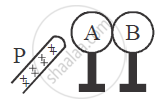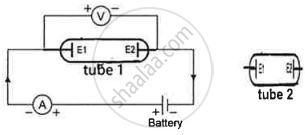Advertisements
Advertisements
प्रश्न
Two conductors are made of the same material and have the same length. Conductor A is a solid wire of diameter 1 mm. Conductor B is a hollow tube of outer diameter 2 mm and inner diameter 1 mm. Find the ratio of resistance RA to RB.
उत्तर
We know that the resistance of wire is `R = ρ l/A` where A is cross-sectional area of conductor and ρ is the specific resistance or resistivity and L is the length of conductor.
The resistance of first conductor
`R_A = (ρl)/(pi(10^-3 xx 0.5)^2`
The resistance of second conductor,
`R_B = (ρl)/(pi[(10^-3)^2 - (0.5 xx 10^-3)^2]`
Now, the ratio of two resistors is given by
`R_A/R_B = ((10^-3)^2 - (0.5 xx 10^-3)^2)/(0.5 xx 10^-3)^2` = 3:1
APPEARS IN
संबंधित प्रश्न
If the potential difference across the ends of a conductor is 220 V and the resistance of the conductor is 44 Ω (ohm), then the current flowing through is _________.
- 0.2 A
- 0.5 A
- 2 A
- 5 A
Name the physical quantity whose unit is "ohm".
Which of the following is an ohmic resistance?
A wire of resistance 3 ohm and length 10 cm is stretched to length 30 cm. Assuming that it has a uniform cross section, what will be its new resistance?
Two metallic spheres A and B kept on insulating stands are in contact with each other. A positively charged rod P is brought near the sphere A as shown in the figure. The two spheres are separated from each other, and the rod P is removed. What will be the nature of charges on spheres A and B?

Define ampere and volt with respect to Ohm’s law.
The variable resistance is called ____________.
Suppose there is a circuit consisting of only resistances and batteries and we have to double (or increase it to n-times) all voltages and all resistances. Show that currents are unaltered. Do this for circuit of Example 3.7 in the NCERT Text Book for Class XII.
The circuit depicted in the figure is employed for studying Ohm's Law. Instead of using a standard resistor, a student opts for a glass tube filled with mercury (tube 1), connected to the circuit through two electrodes E1 & E2. He records the readings of the ammeter and voltmeter, thereby calculating the resistance. The student repeats the experiment by substituting tube 1 with tube 2, where the same amount of mercury fills the tube 2.

Neglecting internal resistance of the cell use (> or < or =) to compare
- the resistance in both the cases.
- the voltmeter readings in both the cases.
- the specific resistance in both the cases.
